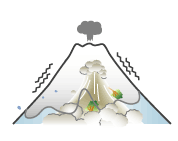Home | Mt. Fuji Volcano Evacuation Map Q&A
Mt. Fuji Volcano Evacuation Map Q&A
 When is Mt. Fuji expected to erupt? When is Mt. Fuji expected to erupt?
Nobody knows for sure, however over the past 2200 years there
have been 75 different eruptions. The most recent eruption
occurred 300 years ago. Recently, small scale earthquakes due
to the movement of magma beneath the Mt. Fuji area have been
regularly observed. Though it may not be soon, Mt. Fuji is
expected to erupt at some point in the future.
What kind of eruption can we expect from Mt. Fuji?
In the past 2200 years, all the eruptions on Mt. Fuji have
come from the sides of the mountain. Large scale eruptions
such as the Houei Eruption in 1707 that continued for 30 years,
and the Jogan Eruption in 864 that produced the Aokigahara
Lava Flow account for only 2% of total eruptions. Statistically
speaking, small scale eruptions from the sides of the mountain
are the most likely to occur. However, since the Houei Eruption
300 years ago, Mt. Fuji has been quiet; possibly storing up
energy for another eruption. We must stay aware of this possibility.
Of what should we be aware in the event of a volcanic eruption?
 If
a change is noticed in the condition of Mt. Fuji, volcanic
observation reports, advisories, and alerts will be broadcast
from the Japan Meteorological Agency(JMA) over TV, radio,
and public announcement services. In the event that evacuation
becomes necessary, instructions will be provided by local
authorities, which should be followed without panic, in a
calm and orderly manner. If
a change is noticed in the condition of Mt. Fuji, volcanic
observation reports, advisories, and alerts will be broadcast
from the Japan Meteorological Agency(JMA) over TV, radio,
and public announcement services. In the event that evacuation
becomes necessary, instructions will be provided by local
authorities, which should be followed without panic, in a
calm and orderly manner.
What should we do to prepare for an eruption?
 First, understand what kind of damage Mt. Fuji can cause as
an active volcano. It is important to discuss communication
and evacuation procedures with family and community in advance.
Also, it is good to prepare a backpack with emergency items
such as first aid, water, non-perishable foods, flashlights,
and extra blankets and clothes. First, understand what kind of damage Mt. Fuji can cause as
an active volcano. It is important to discuss communication
and evacuation procedures with family and community in advance.
Also, it is good to prepare a backpack with emergency items
such as first aid, water, non-perishable foods, flashlights,
and extra blankets and clothes.
What about mudflows from melting snow?
 Mudflows are one of the disastrous effects of a volcano.
If pyroclastic* flows develop during the season when snow
has piled up on Mt. Fuji, then snow will melt in large quantities,
grab rocks and soil, and rush down the mountain at high speed.
Particularly from February through April when large amounts
of snow have piled up on the mountain, we must be aware of
the possibility of dangerous mudflows occurring. Mudflows are one of the disastrous effects of a volcano.
If pyroclastic* flows develop during the season when snow
has piled up on Mt. Fuji, then snow will melt in large quantities,
grab rocks and soil, and rush down the mountain at high speed.
Particularly from February through April when large amounts
of snow have piled up on the mountain, we must be aware of
the possibility of dangerous mudflows occurring.
*Pyroclastic
Flows are a phenomenon caused in an eruption when small broken
rocks and stones mix with hot gasses and rush down the mountain
at high speed. |